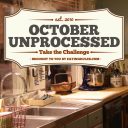Unprocessed FAQ: The Kitchen Test
Sep 20, 2019

We’re just a couple of weeks away from the start of the October Unprocessed challenge! If you haven’t taken the pledge yet, please check it out and then come back here and keep reading.
I get asked a lot of questions about how to define “unprocessed,” and how my definition applies to specific ingredients and foods. I’ve previously published a series of Frequently Asked Questions posts – I’ll be re-publishing them over the next few weeks to bring them to the top of the pile and help everyone prepare for this year’s challenge.
The Kitchen Test
Because there are always so many questions about how to apply my “Kitchen Test,” let’s take a quick look at it:
Unprocessed food is any food that could be made by a person with reasonable skill in a home kitchen with whole-food ingredients.
The Kitchen Test is how I define “unprocessed.” It works well for me, and many people find it works well for them, too. But it may not fit with your definition of “unprocessed,” and that’s totally okay. In fact, I encourage disagreement and discussion, since that’s the best way for us to learn together.
I also recognize that the Kitchen Test isn’t perfect. My goal here isn’t perfection – it’s more to spark a dialogue, increasing awareness about how our food is made, what we’re putting into our bodies, and how we relate to our food.
Whole-Food Ingredients
The Kitchen Test doesn’t mean that you have to make the food. Nor does it mean that you necessarily need to be able to make the food (you don’t have to be Julia Child!). It just requires that the food could be made in a home kitchen by someone who knows what they’re doing, using whole-food ingredients.
So we also have to define “Whole-Food Ingredients.”
I start by trying to figure out if I could grow/create/produce that ingredient at home, at least in theory. If the answer is yes, then it’s good to go. But if it’s made through an industrial or complicated chemical process that couldn’t be done in a kitchen (however you define “kitchen”), or could only be made “in a laboratory,” then it’s out.
The big idea, ultimately, is to consider each ingredient in your food: How it’s produced, where it comes from, and whether its benefits outweigh its detriments.
We’ll talk more about specific ingredients over the next few weeks, but in the meantime, just remember that anything you could make at home, from ingredients that you could produce at home, will pass the test.
Packaged Foods
While cooking from scratch is obviously the ideal choice, it’s not always feasible or practical. Most people (myself included!) are not going to prepare everything from scratch, especially if you’ve got a job, school, kids, pets, or are traveling…
So what to do when you buy packaged food? The answer is simply to consider every ingredient separately.
My favorite example is comparing two “energy bars.” Here are the ingredients for the PowerBar Protein Plus Chocolate Peanut Butter:
trisource protein blend (soy protein isolate, calcium caseinate, whey protein isolate), maltitol syrup, chocolate flavored coating (sugar, fractionated palm kernel oil, cocoa, whey, nonfat milk, soy lecithin, natural flavor), oligofructose (from chicory root), fructose, water, cane invert syrup, peanut butter, partially defatted peanut flour, soy crisps (soy protein isolate, rice flour, salt), peanut oil, and less than 2% of: salt, ground almonds, natural flavor, soy lecithin, butter (cream).
I’ve bolded any ingredients that I’m pretty sure you can’t make at home (some of these might be debatable, but I’ll leave that for the next few posts). Compare that to the ingredients of a Cashew Cookie Larabar:
cashews, dates.
I’m absolutely certain that a person with average skills could make something comparable to the Larabar in his or her kitchen. But the PowerBar? Not so much.
(Since I originally wrote this post, General Mills bought Lara and started introducing new varieties — including “natural flavors” in some of them. The “Uber” bars also used brown rice syrup, which is a concentrated sugar that you probably couldn’t make at home. However, they’ve since “retired” the Uber bars, and it looks like most of their products once again pass the Kitchen Test. Since last year, though, they introduced a “Protein” line that includes pea protein, so those wouldn’t pass the test.)
Restaurant Foods
Eating out is probably the hardest part of the challenge. Since you don’t know the ingredients, you just have to do the best you can. Some dishes are more likely to pass the kitchen test. Here are some strategies I use — if you have other suggestions, please share them in the comments:
- Talk to your waiter. It’s totally okay to tell your waiter that you’re eating only unprocessed food, and ask him or her questions about the food they serve. You’re about to put it in your body – you have every right to know what it is. If the waiter doesn’t know, ask to speak with the Chef. Just remember to be friendly and polite.
- Avoid large, chain restaurants. They often have lots of additives, stabilizers, conditioners, and preservatives in their foods (since they’re rarely made fresh). Obviously that’s a generalization, but you’re usually better off at a small, family- or chef-owned restaurant.
- Find a local, “farm to table” restaurant, if you can. More and more like-minded restaurants are popping up all over the country, so seek them out… and let them know about the challenge!
- A Fresh Salad is usually a good choice. It’s the dressing you’ve got to watch out for. A good choice is Olive Oil and Balsamic Vinegar, both of which pass the Kitchen Test.
- Pasta may pass the test — if it’s made with unbleached, unenriched flour (if you can find 100% whole wheat pasta at a restaurant, you’ll be in good shape). Then you just need to ask about the ingredients in the sauce. Olive oil and garlic, anyone?
- Cooked Vegetables usually work well.
- If you eat meat, that’s usually a good choice, depending on how it’s prepared. (Again, watch the sauce.)
- Tofu and tempeh usually pass the kitchen test. (Seitan is a gray area… You could make seitan at home from wheat flour, but at the commercial level it’s usually made with vital wheat gluten).
The Deliberate Exception Clause
I encourage you to consider exceptions, if any, you will make to your definition of unprocessed. The idea is to decide on any exceptions before we start, if possible. It’s not there for you to use your exceptions as a way to cheat in the moment. Instead, it’s about making an informed decision, in advance, about a particular food.
For example, Matty and I have decided that Vital Wheat Gluten is an acceptable ingredient for us, because we’d rather eat whole grain bread (preferably baked ourselves) that is made with some extra gluten, than to eat bread made with refined grains. We carefully considered it in advance, and decided that the “pros” outweighed the “cons.”
It’s also okay to make an exception for something you feel you need to do to make it possible for you to complete the challenge at all. For example, maybe you’re a five-cans-of-soda-a-day person (like I once was), and have decided that for October, you’re going to limit yourself to just one can of soda each day.
Remember that this is fundamentally an awareness exercise, and ultimately, you need to do what’s right for you, and what’s going to work for you.
If you haven't taken the October Unprocessed pledge yet, please do! And then encourage your friends to join in -- it's a lot more fun that way!






















It is sad that most “foods” in the average super market contain corn / corn by-products and GMO. Government Agricultural policies / subsidy policies are all wrong and mostly to blame for the dangerous position we find ourselves in today. Add to this the simple fact people just do not know how to cook any more…people are lazy…want convienence foods. Also the average person is totally ignorant of the 101 basics of nutrition. The fourth addiction after Drugs, alcohol, tobacco is SUGAR…People consume way too much sugar…most is hidden in processed foods and sodas / energy drinks. The food producers tell us to exercise more..this of course is 110% rubbish…you eat 4000 calories a day..you could exercise for most of the day and not burn it off. Also processed foods are calorie rich but nutritionally void…so we have an Obese nation and a malnurished nation at once….this brings on the… Read more »
Is gum okay?
Unfortunately, most gum won’t pass the kitchen test (check the ingredients, and you’ll immediately see why!).
Glee gum might be the closest commercial chewing gum, but it’s still not completely unprocessed.
Here’s a fun thing to try instead:
http://www.eatingrules.com/2012/10/homemade-honeycomb-gum/
Just found two others that are closer to unprocessed, too. At first glance I can’t tell if they’re really pass the test, but they’re certainly better than Trident or Wrigley’s!
http://www.peppersmith.co.uk/products/real-english-peppermint (and these guys explain each ingredient! how refreshing!)
http://www.chicza.com/english/natural_tasty.html
Look at the ingredients….most have Aspartame as the sweetner…this stuff is poison!
Along with the author of this article, I used to be addicted to gum.
I wouldn’t just chew one stick, I had to have at least two or three; then spit that out and chew two or three more, until the pack was gone. Gum was my cigarettes!
Even my favorite sugarless gum contained sweeteners like Aspartame and/or sugar alcohols (such as Xylitol), it was hard to give up.
After reading this article, I quit cold turkey. Not even choosing Xylitol sweetened gums (as mentioned in the article).
http://foodbabe.com/2011/12/09/wanna-a-piece-of-gum/
There are some really tricky things in condiments. Worchestershire sauce has a few flavorings and preservatives, but I don’t want to try rotting my own anchovies. Soy sauce and hot sauce also have preservatives.
Considering that condiments are meant to be used in small amounts, I don’t sweat it.
I do keep buying the wrong brand of ketchup, and I really should try to make some. And agave syrup should really be subject to truth in labeling. “Organic byproduct” or something.
I’d say, it depends on what the preservative is! (Salt and vinegar being preservatives that have been around since well before “industrialized food.”) I realize this question is more generalized that just the condiments you’ve mentioned, but regarding them specifically: Soy sauce has been made in Japan for centuries; there are brands, even in American supermarkets (and easier to find in health- or natural-food stores) which are just fermented soybeans and salt. I think they’re called “tamari”? Try “ethnic” markets for hot sauce – I picked up a “Louisiana” brand and another Mexican one, a few years ago, that were hot peppers, distilled vinegar, and salt. I throw them out on a shorter schedule than one with multi-syllable preservatives, though! Ketchup . . . . I just look for a shorter ingredient list.
I strive to eat the ways you describe and I sure appreciate encouragement to stay the course and learn more and more as I lay the foundation for health now and into the future. I’m convinced how important eating processed food is a danger to our health and the problems it influences. Thank you. Looking foward to October and promoting the message!
Looking forward to this. Is Miso acceptable?
Thanks,
Tina
Tina, I’ve made miso before! Absolutely. =)
I can hardly wait until October. It’ll be a fun challenge to eat whole foods and unprocessed at the same time. No more commercial bread for me, or pasta, I will concentrate on what I can make at home using veggies, lentils, beans, rice, and fruit. And herbs/spices help with flavor!
This post just makes me more excited for the challenge! I’m slowly (but surely) prepping and stocking my kitchen to be successful in October! While already incorporating more unprocessed eating habits in the meantime 🙂
Have you ever thought of using the word unmanufactured instead of unprocessed? I think that most of the issue lies in those ‘unpronouncable’ names and most of those are manufactured products. I know it doesn’t role off the tongue as easily, but it’s a lot easier to explain!!
Just a reminder for myself…plan, plan, plan! I fail miserably at eating unprocessed only when I fail to plan for it.
Kimberly, me too!
Great post!